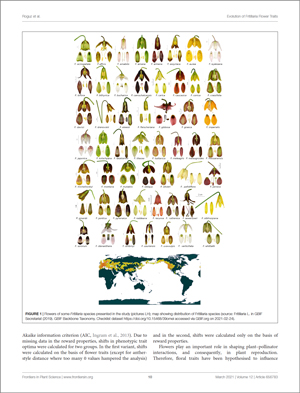NEWS 2021
Evolution of Bird and Insect Flower Traits in Fritillaria L. (Liliaceae)
Katarzyna ROGUZ1, Laurence HILL2, Agata ROGUZ3, Marcin ZYCH1
Frontiers in Plant Science 12: 656783 (2021)
https://doi.org/10.3389/fpls.2021.656783
1Botanic Garden, Faculty of Biology, University of Warsaw, Warsaw, Poland
2Petersham Lodge, Richmond, United Kingdom
3Feature Forest, Gdańk, Poland
Abstract
Pollinators are often perceived as a primary selective agent influencing flower traits such as colour, size, and nectar properties. The genus Fritillaria L. (Liliaceae), comprising approximately 150 species, is described as generally insect pollinated. However, there are at least three exceptions: two hummingbird-pollinated North American species and one passerine-pollinated Asian species. Despite this variation in pollination, little is known about flower traits that may accompany this shift in fritillaries. In this study, we aimed to assess the attractiveness of the floral traits for (new) pollinators and track the evolution of flowers traits in the context of a shift in the principal pollinator. Therefore, we studied 14 flower traits related to the pollination in 60 Fritillaria species and traced the evolutionary trajectory of these traits. We used a phylogenetic tree of the genus, based on five DNA markers (matK, rpl16, and rbcL, 18S, and ITS) to reconstruct the ancestral state of studied flower traits. The results show that in bird-pollinated species several new traits evolved. For example, flower colouration, nectar sugar, and amino acid concentration and composition fulfil the criteria of ornithophilous flowers, although flower traits do not exclude insect pollinators in bird-pollinated fritillaries. Interestingly, we recorded potential reversals from bird to insect pollination. Our analysis, showing a broad study of flower traits among closely related species in the context of pollinator shift, serves as a starting point for future work exploring the genetic and physiological mechanisms controlling flower traits in the genus Fritillaria.




